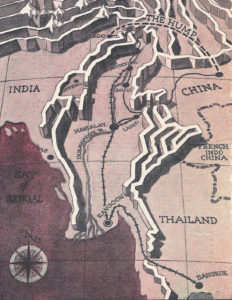
The China Burma India (CBI) Theater of war operations is often considered the forgotten campaign. The purpose of this war was for the Allied powers to prevent the Japanese from invading India. Three armies were used to fight this campaign, led by Field Marshal William Slim from Britain, General Chen Kai-Shek from China and Lt. General Joseph Stilwell from the United States. The motive of this campaign was to stop the Japanese from occupying India. The objective was to get war supplies to China so that country could stay in the war against Japan.
When the Japanese overtook Burma they cut off the Allies only supply route to China. Closure of the Burma Road to Allied armies forced supplies for the Chinese army to be flown over the Himalayan Mountains and land at airfields in China, to deliver war materials to China’s armies. While flying over the mountains Japanese fighter planes would attack and send many Allied planes crashing onto the mountains. Hundreds of planes were lost to enemy fire.
Britain’s main goal in this campaign was to restore its colonies in Southeast Asia, and the English wanted to invade Burma so they could regain control of Singapore. America and Chinese forces were incredibly excited about Britain’s decision to enter the campaign and work to weaken the Japanese hold on the area. America wanted to bomb the supply routes and enemy factories in Burma, to disable Japan’s supply of natural resources used to make war goods. Since the commander of Allied forces in the region was Chen Kai Shek, who was from China, he sided with the Americans and planned to bomb Burma.
After two months of bombing Burma the British finally got what they wanted and the Allies agreed to invade Burma. The Allies began the invasion of Burma in early 1943. At the same time Britain began to invade Burma through India, China invaded Burma from the north and America launched attacks on Indonesia. The Japanese army was now spread very thin while trying to cover and defend three fronts of fighting. Their armies also had to defend against America’s ‘island hopping’ in the Pacific, to free the islands of Iwo Jima, Guam, Bataan and Guadalcanal. Fighting was fierce as the Japanese soldiers had no places to retreat to and were fighting to their deaths.
Since the Japanese were spread so thinly the Allies were quickly able to move into Burma and the rest of southeast Asia. The loss of southeast Asia took away the Japanese’ critical supply sources of rubber they needed to make tires for fighting land vehicles and airplanes. The Allies continued on defeating the Japanese army and then liberated Singapore and Hong-Kong. Once the Allies had defeated Japan in southeast Asia, Japan lost more territories and valuable supply resources for their troops, vehicles and fighter planes. The Allies were then able to reopen the Burma Road for shipping war materials to the Chinese, and increase air raids on Japan, with larger bombers and more destructive bombs.
Many historians call the China-Burma campaign the forgotten campaign, because the battles there were not as major as those in the Pacific and European theaters, but without the Allies being able to take away vital resources from the Japanese, the world would be very different today, had the Japanese prevailed.
hey anyone, I was just checkin out this blog and I really enjoy the basis of the article, and have nothing to do, so if anyone would like to to have an compelling conversation about it, please contact me on AIM, my name is samuel posali